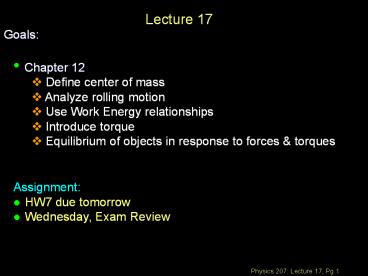Goals: PowerPoint PPT Presentation
1 / 21
Title: Goals:
1
Lecture 17
- Goals
- Chapter 12
- Define center of mass
- Analyze rolling motion
- Use Work Energy relationships
- Introduce torque
- Equilibrium of objects in response to forces
torques
- Assignment
- HW7 due tomorrow
- Wednesday, Exam Review
2
Combining translation and rotation
- Objects can have translational energy
- Objects can have rotational energy
- Objects can have both K ½ m v2 ½ I w2
3
1st A special point for rotationCenter of Mass
(CM)
- A free object will rotate about its center of
mass. - Center of mass Where the system is balanced !
- A mobile exploits this centers of mass.
mobile
4
System of Particles Center of Mass
- How do we describe the position of a system
made up of many parts ? - Define the Center of Mass (average position)
- For a collection of N individual point like
particles whose masses and positions we know
RCM
m2
m1
r2
r1
y
x
(In this case, N 2)
5
Sample calculation
m at ( 0, 0) 2m at (12,12) m at (24, 0)
- Consider the following mass distribution
XCM (m x 0 2m x 12 m x 24 )/4m meters YCM
(m x 0 2m x 12 m x 0 )/4m meters XCM 12
meters YCM 6 meters
6
System of Particles Center of Mass
- For a continuous solid, one can convert sums to
an integral.
dm
r
y
x
where dm is an infinitesimal mass element but
there is no new physics.
7
Connection with motion...
- An unconstrained rigid object with rotation and
translation rotates about its center of mass! - Any point p rotating
8
Work Kinetic Energy
- Work Kinetic-Energy Theorem ?K WNET
- Applies to both rotational as well as linear
motion. - What if there is rolling without slipping ?
9
Same Example Rolling, without slipping, Motion
- A solid disk is about to roll down an inclined
plane. - What is its speed at the bottom of the plane ?
10
Rolling without slipping motion
- Again consider a cylinder rolling at a constant
speed.
2VCM
CM
VCM
11
Motion
- Again consider a cylinder rolling at a constant
speed.
Both with VTang VCM
Rotation only VTang wR
Sliding only
2VCM
VCM
CM
CM
CM
VCM
If acceleration acenter of mass - aR
12
Example Rolling Motion
- A solid cylinder is about to roll down an
inclined plane. What is its speed at the bottom
of the plane ? - Use Work-Energy theorem
Mgh ½ Mv2 ½ ICM w2 and v wR Mgh ½
Mv2 ½ (½ M R2 )(v/R)2 ¾ Mv2 v 2(gh/3)½
13
How do we reconcile force, angular velocity and
angular acceleration?
14
From force to spin (i.e., w) ?
A force applied at a distance from the rotation
axis gives a torque
a
FTangential
F
q
Fradial
r
r
FTangential
Fradial
FTang sin q
- If a force points at the axis of rotation the
wheel wont turn - Thus, only the tangential component of the force
matters - With torque the position angle of the force
matters
- ?NET r FTang r F sin q
15
Rotational Dynamics What makes it spin?
- ?NET r FTang r F sin q
- Torque is the rotational equivalent of force
- Torque has units of kg m2/s2 (kg m/s2) m N m
?NET r FTang r m aTang
r m r a (m r2)
a For every little part of the wheel
16
Torque
- The further a mass is away from this axis the
greater the inertia (resistance) to rotation
?NET I a
- This is the rotational version of FNET ma
- Moment of inertia, I Si mi ri2 , is the
rotational equivalent of mass. - If I is big, more torque is required to achieve
a given angular acceleration.
17
Rotational Dynamics
a
FTangential
F
Fradial
- ?NET I a r F sin q
r
- A constant torque gives constant angular
acceleration if and only if the mass distribution
and the axis of rotation remain constant.
18
Torque, like w, has pos./neg. values
- Magnitude is given by (1) r F sin q
- (2) Ftangential r
- (3) F rperpendicular to line of
action - Direction is parallel to the axis of rotation
with respect to the right hand rule - And for a rigid object ? I a
r sin q
line of action
F cos(90-q) FTang.
r
a
90-q
q
F
F
F
Fradial
r
r
r
19
Statics
Equilibrium is established when
In 3D this implies SIX expressions (x, y z)
20
Example
- Two children (30 kg 60 kg) sit on a horizontal
teeter-totter. The larger child is at the end of
the bar and 1.0 m from the pivot point. The
smaller child is trying to figure out where to
sit so that the teeter-totter remains horizontal
and motionless. The teeter-totter is a uniform
bar of length 3.0 m and mass 30 kg. - Assuming you can treat both children as point
like particles, what is the initial angular
acceleration of the teeter-totter when the large
child lifts up their legs off the ground (the
smaller child cant reach)? - The moment of inertia of the bar about the pivot
is 30 kg m2. - For the static case
21
Example Soln.
30 kg
- Draw a Free Body diagram (assume g 10 m/s2)
- 0 300 d 300 x 0.5 N x 0 600 x 1.0
- 0 2d 1 4
- d 1.5 m from pivot point
22
Recap
- Assignment
- HW7 due tomorrow
- Wednesday review session

